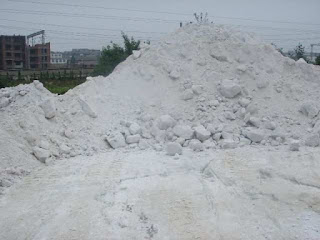mineral crushing device
In beneficiation plant, the
types, sizes, and number of crushers employed in a complete reduction system
will vary with such factors as the volume of ore to be processed, ore hardness,
and the size of the feed and product.
GyratoryCrushers. Primary
crushers are heavy-duty machines run in open circuit (sometimes in conjunction
with scalping screens or grizzlies). They handle dry run-of-mine feed material
as large as 1 m. There are two main types of primary crushers—gyratory crushers
and jaw crushers. Gyratory crushers are the most common for new operations.
Secondary
crushers are lighter-duty and include cone crushers, roll crushers, and impact
crushers. Generally, the feed to these machines will be less than 15 cm, and
secondary crushing is usually done on dry feed. Cone crushers are similar to
gyratory crushers, but differ in that the shorter spindle of the cone is not
suspended but is supported from below by a universal bearing. Also, the bowl
does not flare as in a gyratory crusher. Cone crushers are generally the
preferred type of secondary crusher because of their high reduction ratios and
low wear rates. However, impact crushers are used successfully for relatively
nonabrasive materials such as coal and limestone. Frequently, size reduction
with secondary crushers is accomplished in closed circuit with vibrating
screens for size separation.
The
gyratory crusher is used as a primary and secondary stage crusher. The cone
crusher is used as a secondary, tertiary, and quaternary crusher. The action of
a typical gyratory-type crusher is illustrated in Figure 1. In gyratory
crushers the crushing process comprises reduction by compression between two
confining faces and a subsequent freeing movement during which the material
settles by gravity until it is caught and subjected to further compression and
again released. The particles are subjected to maximum breaking forces when
they are on the side with the minimum gape.
Fig1.cutway of gyratory
crusher
In the
normal gyratory, the crushing stroke or travel of the head usually has an
important bearing on the size of the finished product, although this factor is
subject to modification when a parallel sizing zone is adopted. The movement of
the head in the cone crusher is similar to that in the ordinary gyratory with
an exception—toward the bottom of the cone, the head travels through a much
greater distance and gyrates much faster (see cutaway in Figure2). The long
movement changes the crushing stroke from slow compression to fast compression,
and the increased clearance on the freeing stroke allows the material to fall
away vertically after each impact.
Fig2. Cutaway of cone crusher
ImpactCrushers. Impact devices
are often used for fine crushing. One type, a hammer mill, uses hammers
rotating at high speed to break particles. Another type, an VSI impact crusher,
accelerates particles with a rotor causing them to impact a curtain of falling
particles (Figure 3). The latter has a significant advantage from a wear point
of view.
FIG3.
VSI crusher




评论
发表评论